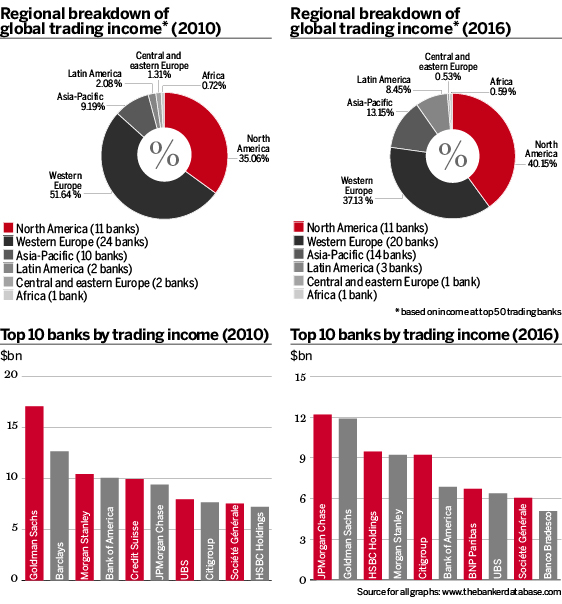Data collected by The Banker affirms claims that North American markets businesses have an edge over their European peers. But as Danielle Myles explains, the margin is smaller than many perceive.
One of the most common criticisms of European corporate and investment banks (CIBs) of late is their loss of market share to US rivals. Trading, rather than advisory or capital markets origination, is often the subject of these claims.
Indeed, European management teams have targeted capital-intensive activities – most notably fixed-income, currencies and commodities (FICC) – as part of group-wide restructuring intended to cut risk-weighted assets and use balance sheets more efficiently.
Data collected by The Banker suggests that the criticism directed at some of Europe’s biggest CIBs is not without merit, but a more nuanced picture emerges once one looks beyond the top 10. Examining the regions as a whole, Europe’s trading industry is revealed to be in better shape than is widely perceived.
Four-way split
Between 2010 and 2016, western European banks’ share of trading income earned by the world’s top 50 trading banks fell by more than 14 percentage points. While this is a marked decline, the starting point was high: seven years ago, the region’s banks were generating 51.64% of global trading income.
Over the same time period, CIBs across the Atlantic have made gains, but have not picked up all the business lost by western Europe. Their share of the global trading wallet has increased by just over five percentage points. Asia-Pacific and Latin America were the other markets to gain at western Europe’s expense, picking up four and six percentage points, respectively.
By this analysis, western Europe trails North America by just three percentage points, a margin that hardly supports warnings about the dire state of the region’s trading industry. However, a different picture emerges when the data sample is reduced.
Consolidation versus fragmentation
In both 2010 and 2016, only 11 North American CIBs featured in the top 50, but the big five – JPMorgan, Goldman Sachs, Morgan Stanley, Citi and Bank of America – are in the top eight. Western Europe, on the other hand, accounts for 37% of the top 50 performers but only four make the top 10, and with the exception of HSBC, they are in the chaser pack.
This dichotomy is consistent with broader industry trends, in that the US market has consolidated while Europe’s remains fragmented. The latter situation has hit regional profits, but it does mean Europe has a strong group of solid, second-tier trading houses. These include the likes of France’s Groupe BPCE and Credit Agricole, Spain’s BBVA and Santander, and the Nordics’ Danske, Nordea and DNB. The US, on the other hand, has no sizeable trading houses aside from its five big CIBs. North America’s next most profitable – Royal Bank of Canada, Scotiabank and Bank of Montreal – hail from the US’s northern neighbour.
Standout trading houses
Last year Goldman Sachs lost its title as the world’s preeminent trading house to JPMorgan, which back in 2010 ranked just sixth. HSBC and BNP Paribas have increased their market share to become the continent’s leading trading houses. The latest league tables prepared by data firm Coalition show that the French bank has the fastest growing FICC business in the US.
Coalition data also provides a breakdown of which bank is leading which asset class. JPMorgan dominates FICC globally and equities in Europe. The leading equities trading business in Asia is UBS, while Morgan Stanley leads in the Americas.
Latin America’s huge gains are largely down to Banco Bradesco and Itaú Unibanco which, respectively, have quadrupled and doubled their trading income since 2010. Bradesco has become the first bank outside the US or western Europe to make the global top 10.
All data sourced from www.thebanker.com



